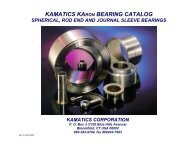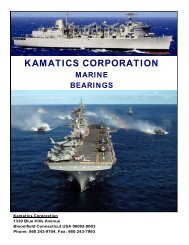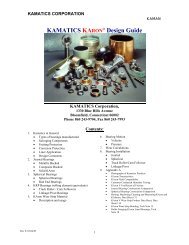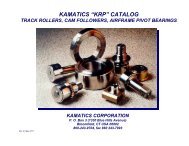kamatics wear strip selection guide - Kaman Corporation
kamatics wear strip selection guide - Kaman Corporation
kamatics wear strip selection guide - Kaman Corporation
You also want an ePaper? Increase the reach of your titles
YUMPU automatically turns print PDFs into web optimized ePapers that Google loves.
KAMATICS WEAR STRIP SELECTION GUIDE<br />
Kamatics offers multiple types of Wear Strips, each providing unique characteristics to prevent metal-tometal<br />
<strong>wear</strong>/fretting damage caused by sliding or rubbing surfaces. Kamatics Wear Strips are designed<br />
for bonding onto surfaces to act as a protective barrier. They are available in standard sizes or in custom<br />
cut profiles.<br />
DESCRIPTION:<br />
KAron V Wear Strip consists of standard KAron Grade V self-lubricating bearing material applied on to a thin<br />
fiberglass substrate. The KAron V bearing material provides a low sliding friction for <strong>wear</strong> resistance. KAron V<br />
Wear Strip comes with a removable woven nylon peel-ply on the back of the fiberglass to protect the bonding<br />
surface from dirt and debris.<br />
P54 Wear Strip is a thin sheet self-lubricating bearing material comprised of a resilient thermoset resin matrix<br />
with synthetic fibers in a laminate construction for strength and durability. P54 Wear Strip comes with a<br />
removable woven nylon peel-ply on one surface to protect the bonding surface from dirt and debris.<br />
Ultra Light Duty Wear Strip is a specially formulated low friction <strong>wear</strong> resistant material, which is a similar in<br />
construction to P54, except for its thin cross section of 0.010” (0.25mm). The upper <strong>wear</strong> resistant surface has<br />
self-lubricating properties, and the backside of the material is textured to insure maximum bond adhesion.<br />
APPLICATION INFORMATION:<br />
KAron V Wear Strip is designed for surfaces that are subjected to light to medium duty rubbing pressure, or as a<br />
fretting resistant barrier. The mating sliding material should be smooth, hard, and a corrosion resistant surface.<br />
For optimal KAron V liner performance, the sliding component should have a minimum surface roughness of 16<br />
RMS (0.4 µm), and be in full contact with the KAron V Wear Strip to avoid line or point loads.<br />
P54 Wear Strip is designed for applications where standard off-the-shelf <strong>wear</strong> resistant plastics fall short in<br />
performance. P54 Wear Strip can be used where impact resistance is required, under edge loading, in heavy<br />
abrasion applications, and where gross amounts of contaminants can be expected. P54 Wear Strip can operate<br />
against rough surfaces and against soft materials such as aluminum or composites.<br />
Ultra Light Duty Wear Strip has a unique thin cross section, which makes it ideal for exterior aerospace surface<br />
applications that require an extremely low profile or high flexibility. The mating sliding material should be smooth,<br />
hard, and a corrosion resistant surface. For optimal Ultra Light Duty Wear Strip performance, the sliding<br />
component should have a minimum surface roughness of 16 RMS (0.4 µm), and be in full contact with the Ultra<br />
Light Duty Wear Strip to avoid line or point loads.<br />
Kamatics Wear Strips are flexible and can conform to the contour of a mounting surface – please consult<br />
Kamatics Engineering for application design recommendations.<br />
KAMATICS<br />
KAMATICS<br />
KAMATICS <strong>Corporation</strong><br />
1330 Blue Hills Avenue<br />
Bloomfield, CT 06002<br />
860-243-9704<br />
Rev. NC, 01/02/2008 P. 1 of 5<br />
KAMAN
KAMATICS WEAR STRIP SELECTION GUIDE<br />
PHYSICAL PROPERTIES 1 :<br />
Coefficient<br />
of Friction<br />
Max Static<br />
Load<br />
Max Dynamic<br />
Load<br />
Operating<br />
Temperature<br />
KAron V<br />
Wear Strip<br />
Rev. NC, 01/02/2008 P. 2 of 5<br />
P54 Wear Strip<br />
Ultra Light Duty<br />
Wear Strip<br />
0.04 – 0.08 0.06 – 0.08 0.04 – 0.1<br />
30,000 psi<br />
(207 MPa)<br />
10,000 psi<br />
(69 MPa)<br />
-100°F to 250°F<br />
(-73°C to 120°C)<br />
Table 1<br />
50,000 psi<br />
(345 MPa)<br />
20,000 psi<br />
(138 MPa)<br />
-65°F to 250°F<br />
(-54°C to 120°C)<br />
20,000 psi<br />
(138 MPa)<br />
10,000 psi<br />
(69 MPa)<br />
-65°F to 250°F<br />
(-54°C to 120°C)<br />
1 Above reported values based on <strong>wear</strong> <strong>strip</strong> only. Physical properties in service will be largely dependent upon<br />
operating conditions, the mating surface, the adhesive bond integrity, the substrate material, and surface<br />
preparation of the substrate.<br />
FLUID COMPATIBILITY:<br />
Kamatics Wear Strips are not affected by the following chemicals: Phosphate Ester Hydraulic Fluid (Skydrol),<br />
MIL-T-5624 Turbine Fuel Grade JP-4, MIL-PRF-7808 Lubricating Oil, MIL-PRF-5606 Hydraulic Oil, MIL-A-8243<br />
Anti-Icing Fluid, MIL-H-83282 Hydraulic Fluid, Fresh Water, Salt Water.<br />
ENVIRONMENTAL TESTING:<br />
Kamatics KAron V and P54 bearing materials performed very well in independent laboratory testing. The<br />
methods used for the testing were MIL-STD-810F Environmental Engineering Considerations and Telecordia<br />
General Requirements. When subjected to tests for High and Low Temperatures, Solar Radiation, Blowing Rain,<br />
Fungus, Humidity, Salt Fog, Blowing Dust, Functional Shock, and Ozone Resistance, the Kamatics bearing<br />
material test samples showed no signs of damage or degradation.
KAMATICS WEAR STRIP SELECTION GUIDE<br />
ORDERING INFORMATION:<br />
Standard Kamatics Wear Strip materials are available in flat sheets up to 12" x 48" (305 x 1219 mm). Kamatics<br />
Wear Strips are also available in cut <strong>strip</strong>s as narrow as 1/2” wide up to the maximum sizes. For washers of<br />
various sizes, and custom cut shapes and profiles, contact Kamatics for ordering information. Wear Strip bearing<br />
materials are available in the following grades:<br />
Wear Strip Type<br />
Material<br />
Letter<br />
KAron V Wear Strip S<br />
P54 Wear Strip P<br />
Wear Strip<br />
Grade<br />
Rev. NC, 01/02/2008 P. 3 of 5<br />
Product<br />
Description<br />
Nominal Thickness,<br />
inches (mm)<br />
100 Light Duty 0.018 (0.46)<br />
200 Medium Duty 0.036 (0.91)<br />
020 Light Duty 0.020 (0.5)<br />
032 Medium Duty 0.032 (0.8)<br />
060 Heavy Duty 0.060 (1.5)<br />
120 Plate Stock 0.120 (3.0)<br />
Ultra Light Duty Wear Strip U 010 Ultra Light Duty 0.010 (0.25)<br />
Table 2<br />
STANDARD PART NUMBERING SYSTEM:<br />
For standard cut <strong>strip</strong> dimension parts, Kamatics uses the following part numbering system:<br />
KW __ __ __ __ __ __ –– __ __ __ –– __ __ __<br />
Kamatics Wear Strip<br />
Material Letter<br />
Units of Measure<br />
Wear Strip Grade<br />
Optional Pull Tab<br />
Material Letter = S for KAron V Wear Strip<br />
P for P54 Wear Strip<br />
U for Ultra Light Duty Wear Strip<br />
Unit of Measure = (BLANK) for English units<br />
M for Metric units<br />
Wear Strip Grade = See Table 2 above<br />
Optional Pull Tab = (BLANK) for no Pull Tab<br />
T for optional Pull Tab – KAron V Wear Strip ONLY – 3/8” Pull Tab for easy<br />
removal of peel-ply backing<br />
Width = English units: width in 1/8" increments up to 12", example 024 = 3" wide<br />
Metric units: width in 5mm increments up to 300mm, example 020 = 100mm wide<br />
Length = English units: length in 1/4" increments up to 48", example 096 = 24" long<br />
Metric units: length in 10mm increments up to 1200mm, example 050 = 500mm long<br />
Part Number Examples:<br />
KWS100T-016-192 = KAron V Light Duty Wear Strip, 2” x 48”, with pull tab<br />
KWSM200-007-095 = KAron V Medium Duty Wear Strip, 35mm x 950mm, no pull tab<br />
KWP060-096-192 = P54 Heavy Duty Wear Strip, 12” x 48”<br />
KWU010-048-096 = Ultra Light Duty Wear Strip, 6” x 24”<br />
Width<br />
Length
KAMATICS WEAR STRIP SELECTION GUIDE<br />
BONDING PROCEDURE:<br />
KAron V Wear Strip comes with a removable woven nylon peel-ply on the back of the fiberglass to protect the<br />
bonding surface from dirt and debris. When the pull tab (T) option is called out in the part number, a 3/8" (9.5mm)<br />
long breakaway tab will be provided for easy removal of the peel ply backing. With the peel-ply removed and the<br />
back surface exposed, the KAron V Wear Strip is prepared and ready for bonding on to a suitable surface.<br />
P54 Wear Strip comes with a removable woven nylon peel-ply on one surface to protect the bonding surface<br />
from dirt and debris. With the peel-ply removed and the back surface exposed, the P54 Wear Strip is prepared<br />
and ready for bonding on to a suitable surface.<br />
Ultra Light Duty Wear Strip is intentionally textured on the backside to insure maximum adhesion. The textured<br />
surface can always be identified by its light brown/gray color versus the dark brown/black color of the smooth<br />
running surface. Careful preparation of the textured Ultra Light Duty Wear Strip bonding surface is imperative to<br />
ensure a proper bond, and it should be cleaned with an appropriate solvent (e.g. isopropyl alcohol) immediately<br />
prior to bonding.<br />
Standard room-temperature curing structural epoxy adhesives are recommended for bonding Kamatics Wear<br />
Strip material, such as Hysol EA9309 (Henkel Loctite Aerospace), Hysol EA9396 (Henkel Loctite Aerospace),<br />
Hysol EA9460 (Henkel Loctite Industrial), Scotchweld 460 (3M Co.), and Araldite 2011 (Huntsman). Follow the<br />
manufacturer's suggested procedures for maximum adhesion to the mating surface. The mating adherent surface<br />
should have or be roughened to a finish of greater than 63 RMS (1.6 µm), and be cleaned with an appropriate<br />
solvent (e.g. isopropyl alcohol) immediately prior to bonding.<br />
Anti-fretting coating<br />
The “active” part of<br />
the <strong>wear</strong> <strong>strip</strong>, this is<br />
the protective barrier<br />
inserted between two<br />
contact surfaces.<br />
Surface Preparation<br />
Roughened and cleaned<br />
area, ready for bonding of<br />
KAMATICS Wear Strip.<br />
Rev. NC, 01/02/2008 P. 4 of 5<br />
Woven nylon peel-ply<br />
This removable layer<br />
(gray in color) protects<br />
the bonding side of the<br />
Wear Strip until<br />
substrate surface prep is<br />
complete and ready for<br />
bonding agent.
KAMATICS WEAR STRIP SELECTION GUIDE<br />
WEAR STRIP PRODUCTS WITH “SELF-STICK” ADHESIVE:<br />
Kamatics manufactures several <strong>wear</strong> <strong>strip</strong> products with an integral acrylic pressure sensitive “self-stick” adhesive<br />
for ease of assembly. This form of adhesive is suitable for non-contaminated applications below 150°F (66°C).<br />
Kamatics <strong>wear</strong> <strong>strip</strong>s with self-stick adhesive are custom products – contact Kamatics for product availability.<br />
SELF-STICK BONDING PROCEDURE:<br />
The following instructions are recommended for optimum self-stick adhesive strength.<br />
Surface preparation<br />
The self-stick adhesive will adhere well to most clean, dry surfaces. Typical surface cleaning solvents are a 50/50<br />
isopropyl alcohol (rubbing alcohol)/water mixture. Scrubbing the surfaces with a solvent saturated mild abrasive<br />
pad and then wiping the surface with a clean cloth to remove the solvent and contaminants provides good results.<br />
Follow solvent manufacturer's precautionary warnings and suggested handling procedures when using solvents.<br />
Step 1: Solvent wipe Step 2: Clean dry Step 3: Apply adhesive<br />
with pressure<br />
Bonding Pressure<br />
Bond strength is dependent upon the amount of adhesive-to-surface contact developed. Firm application<br />
pressure develops better adhesive contact and thus improves bond strength. The most common technique is to<br />
apply the exposed self-stick adhesive backing onto the cleaned surface, then apply very firm pressure to the<br />
entire bond line. This can be accomplished by rolling a soft hand-held plastic roller against the <strong>wear</strong> <strong>strip</strong> surface,<br />
or by clamping a solid face sheet against the <strong>wear</strong> <strong>strip</strong> surface.<br />
Application Temperature<br />
Ideal adhesive application temperature range is 70°F to 100°F (21°C to 38°C). Initial application to surfaces at<br />
temperatures below 50°F (10°C) is not recommended because the adhesive becomes too firm to adhere readily.<br />
However, once properly applied, low temperature holding is generally satisfactory.<br />
Dwell Time<br />
After application, the bond strength increases and approaches the ultimate bond strength after 72 hours at 70°F<br />
(21°C). In some cases bond strength can be increased and ultimate bond strength can be achieved more quickly<br />
by exposure of the bond to elevated temperatures; i.e. 150° F (66° C) for 1 hour. This provides quicker and more<br />
thorough adhesive wet out onto the substrate.<br />
KAMATICS<br />
KAMATICS<br />
KAMATICS <strong>Corporation</strong><br />
1330 Blue Hills Avenue<br />
Bloomfield, CT 06002<br />
860-243-9704<br />
Rev. NC, 01/02/2008 P. 5 of 5<br />
KAMAN







